Are you wondering how you’re supposed to measure Solar Access Value (SAV) and Total Solar Resource Fraction (TSRF) with accuracy? Or maybe you’re wondering if accuracy even matters?
Measuring Solar Access Value (SAV) & Total Solar Resource Fraction (TSRF) With Accuracy
Article from | EagleView Technologies
Are you wondering how you’re supposed to measure Solar Access Value (SAV) and Total Solar Resource Fraction (TSRF) with accuracy? Or maybe you’re wondering if accuracy even matters?
You’re not alone. These are big questions facing many solar contractors right now.
The short answer is there are several methods to calculate these solar property data points, from 3D modeling to handheld devices to aerial imagery, but not all of them are accurate.
As for whether accuracy matters when it comes to SAV and TSRF values, it depends. Does having an accurate electricity production estimate matter? (Hint: yes) If so, you need accurate SAV and TSRF numbers, because that’s what your estimate is based on.
In this article, we’ll dive into these questions in more detail so you can make the best decision for your company. But first, the basics…
The basics: What is SAV and TSRF?
Solar Access Value (SAV) is a measure of how much sunlight reaches a solar PV system after accounting for direct and indirect irradiance and the impact of shade. SAV is reported as a percentage, with 100% being full solar radiation not inhibited by shade.
Total Solar Resource Fraction (TSRF) is an efficiency rating that takes into account solar access value as well as the tilt and orientation factor (TOF) for a specific geographic location. TSRF is also reported as a percentage, with 100% being the optimal value.
How important is SAV and TSRF accuracy for contractors?
Very. The electrical production of a solar PV system depends directly on the amount of sunlight the system receives. Since SAV and TSRF both measure the amount of sunlight that reaches the system, they’re critical inputs when calculating the estimated electricity production.
So, if you want to give homeowners an accurate electricity production estimate, you need accurate SAV and TSRF input values.
You might be thinking that an accurate estimate only matters if you’re offering a performance guarantee or selling a PPA. But regardless of how the system is financed, the main reason
homeowners install solar panels is to generate enough electricity to save money.
Providing an accurate estimate of electricity production during the sales process sets proper expectations so the homeowner knows how much money they can expect to save every month.
Not only does this improve customer satisfaction, but it also drives up positive reviews and referral rates. Referrals are one of the best ways to reduce soft costs related to customer acquisition (which are ballooning industry-wide) and increase your close rate.
On the other hand, if a solar electric system underperforms compared to your estimate, you’re going to have unhappy customers. Unfortunately, this situation happens far too often and has created an undercurrent of distrust between consumers and the solar industry, ultimately impacting solar adoption in the US.
Misleading a consumer on the savings they will receive or the electrical production of the system is almost always the result of poor designs, over- or under-sizing the PV system, or miscalculating electrical production, all due to inaccurate SAV considerations.
How effective is 3D modeling for measuring SAV & TSRF?
Many solar contractors currently measure SAV and TSRF by building out a 3D model and a shade scene of the property. Unfortunately, this process is very prone to human error.
SAV and TSRF values derived from 3D modeling tend to vary from user to user and project to project, with a degree of accuracy that’s always fluctuating. For this reason, it’s difficult to know whether your models are accurate and to identify the source of error when discrepancies arise.
For example, a contractor recently shared a story with us where a homeowner said their solar installation was producing 13% less than they estimated. The contractor reviewed their calculations and the models they used during the proposal but couldn’t find any errors.
So, they used EagleView’s TrueDesignTM solution to replicate their initial design, and it confirmed that the system would under-produce by 13%. Had they known this during the proposal stage, the contractor could’ve set accurate expectations during the sales process.
Using handheld devices for measuring SAV & TSRF
While 3D modeling has become the most popular method for measuring SAV and TSRF, there are some contractors who still use handheld devices on the roof surface to check irradiance and shade. Just as with 3D modeling, however, handheld devices produce subjective results based on user operation or interpretation.
In fact, a recent study by DNV (previously DNV-GL) compared the Solmetric SunEye 210 handheld device against EagleView’s Inform Advanced aerial imagery.
Four residential properties in the San Francisco Bay Area served as test sites for the study and were chosen based on the diversity of the type of shade affecting them, such as nearby buildings, trees, and shade-causing objects on the rooftop.
The study found that using both EagleView Inform Advanced and the Solmetric SunEye produced nearly identical solar access values, with an average difference of -1% to 0%.
However, DNV noted that because handheld measurements require experienced personnel, the results are likely to vary among technicians. They found that EagleView can mitigate some of this risk for solar contractors, particularly the uncertainty associated with the repeatability of on-site measurements.
DNV’s report also noted that EagleView Inform Advanced can provide solar access values at more locations on a roof than could be practically measured and processed manually, providing contractors with more data to make an accurate estimate.
How to measure SAV & TSRF using EagleView
So if you don’t build out a 3D model and you don’t climb up on the roof with a handheld device, how exactly do you measure SAV and TSRF with EagleView?
Easy. You just click a button and order a report. Here’s what it looks like:
Step 1: Input the property address
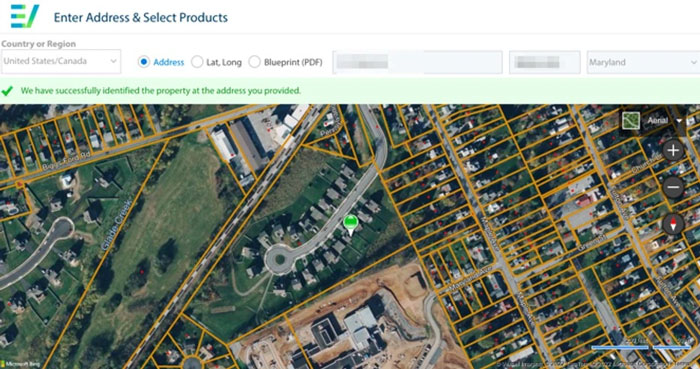
EagleView's large geospatial data and imagery library encompasses 94% of the U.S. population, making it highly likely that imagery for your property will be available. Plus, EagleView’s imagery includes both top-down (ortho) and side-angled (oblique) views so you’ll have complete remote visibility of residential properties for solar prospecting, planning, and validation.
Step 2: Select the tool you need
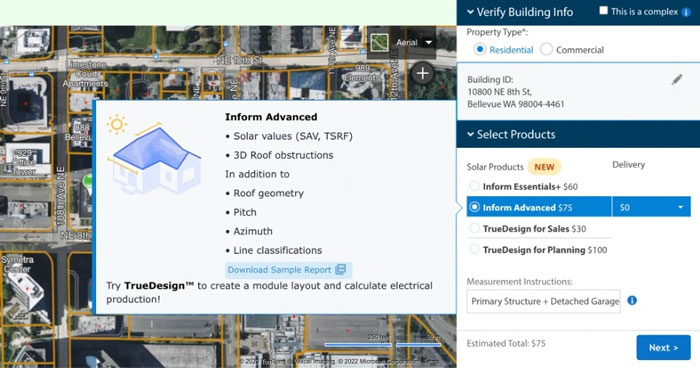
To receive solar values like SAV, TSRF, and TOF for the property, select the Inform Advanced product in this step. EagleView Informed Advance provides guaranteed accuracy for roof dimensions and obstructions, with an accuracy level greater than or equal to 98% for TSRF and SAV. And your shade data is validated by DNV.
Step 3: Submit your order
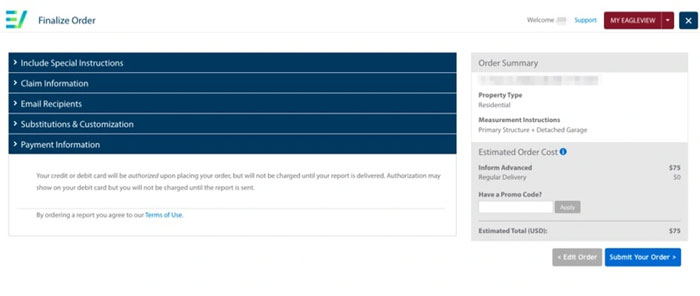
Next, you can choose who you want the solar report emailed to and submit your order. The Inform Advanced product provides all the data you need to completely skip the external site visit — allowing you to reduce or eliminate the labor, fuel, travel, equipment, and insurance costs associated with manual inspections.
Step 4: Receive a report with accurate SAV and TSRF values
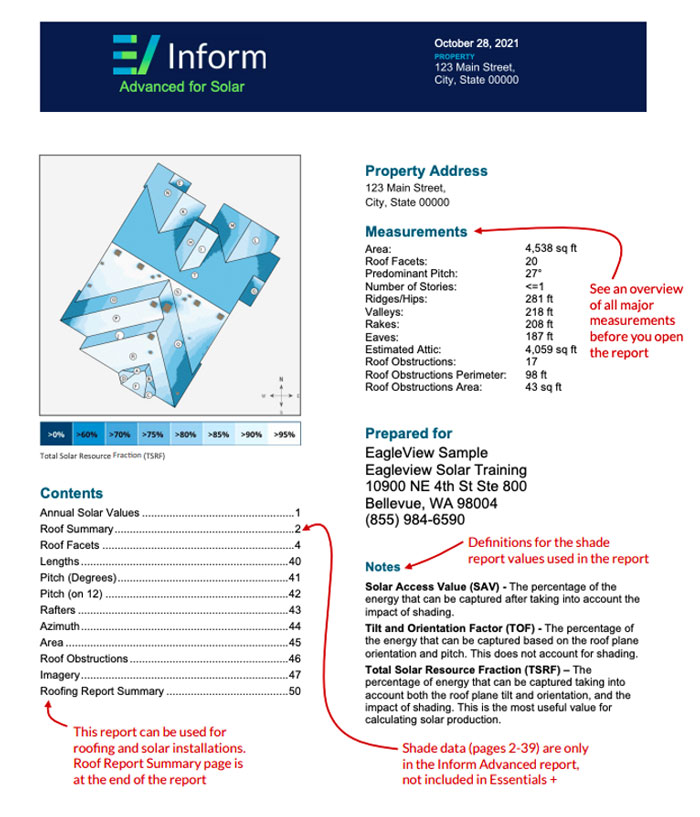
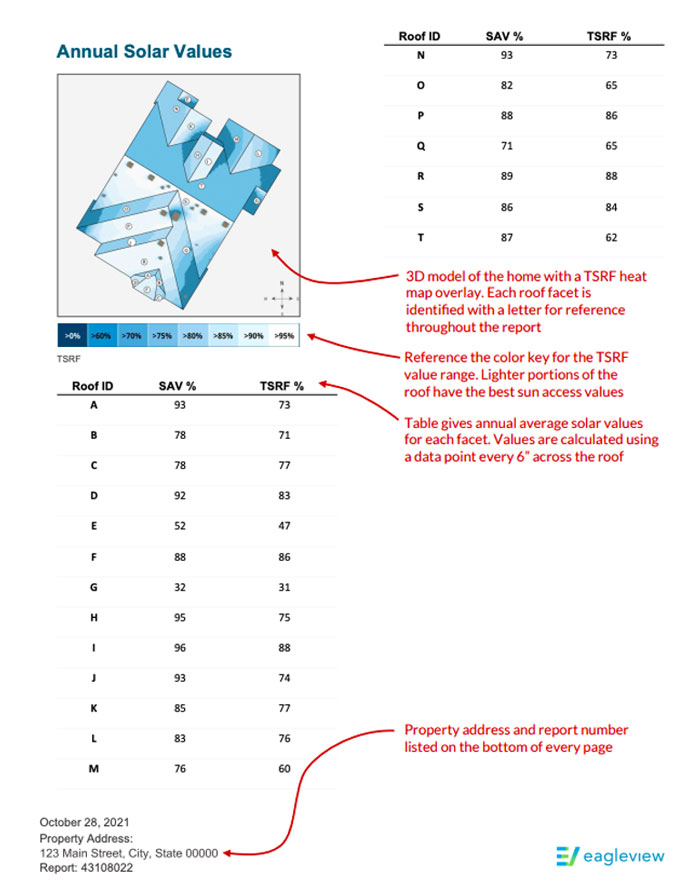
After you submit your order, you’ll quickly receive a full report like the one shown above with data derived from high-accuracy aerial imagery. The report includes SAV and TSRF values for the property, a 3D model of the home, and a TSRF heat map overlay. This data is delivered in a variety of formats including PDF, XML, JSON and even DXF files that can be imported directly into CAD software.
It also breaks down SAV and TSRF values for each roof facet so you can calculate an accurate electricity production estimate based on your system design using PVWatts or a similar tool.
Author’s note: This is only one use case of how EagleView helps to measure SAV & TSRF; if you want more than just the data, TrueDesign not only provides SAV & TSRF with the same degree of accuracy but enables solar design and calculates estimated kWh production. That’s not all, the EagleView ordering process also offers many API methods which allow for varying degrees of customization.
Use a non-subjective source of truth to measure solar power
SAV and TSRF accuracy are important, and so is the estimated electrical production that’s calculated from them. It’s important for the consumer to receive what they were promised, and it’s important for the contractor to do good business and receive more referrals — the best leads you can get.
Methods of SAV and TSRF calculation that require human input will always vary from user to user. So, it’s best to use a tool that provides a non-subjective source of truth; one that isn’t prone to human error or dependent on human interpretation.
EagleView provides solar intelligence that’s extracted from high-resolution aerial imagery. The solar access values we deliver are extremely accurate and always consistent.
This type of solar intelligence provides the entire industry with a new standard of accuracy, enabling efficiencies for contractors and a trustworthy, third-party source of truth for the consumer.
The content & opinions in this article are the author’s and do not necessarily represent the views of AltEnergyMag
Comments (0)
This post does not have any comments. Be the first to leave a comment below.
Featured Product

